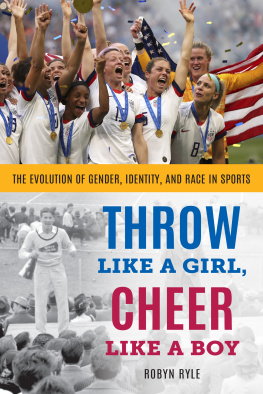A Locker Room of Her Own
A LOCKER ROOM OF HER OWN
Celebrity, Sexuality, and Female Athletes
Edited by David C. Ogden and Joel Nathan Rosen

www.upress.state.ms.us
The University Press of Mississippi is a member
of the Association of American University Presses.
Copyright 2013 by University Press of Mississippi
All rights reserved
Manufactured in the United States of America
First printing 2013
Library of Congress Cataloging-in-Publication Data
A locker room of her own : celebrity, sexuality, and
female athletes / David C. Ogden and Joel Nathan
Rosen, editors.
pages cm
Includes bibliographical references and index.
ISBN 978-1-61703-813-6 (cloth : alk. paper)
ISBN 978-1-61703-814-3 (ebook) 1. Women
athletesUnited StatesBiography. 2. Lesbian
athletesUnited StatesBiography. 3. Women athletes
United StatesSexual behavior. 4. Women
athletesUnited StatesPublic opinion. 5. Public
opinionUnited States. I. Ogden, David C. II. Rosen,
Joel Nathan, 1961
GV697.A1L62 2013
796.0922dc23
[B]
2012050121
British Library Cataloging-in-Publication Data available
Contents
ROBERTA J. NEWMAN
DAVID C. OGDEN AND JOEL NATHAN ROSEN
MARTHA REID
KIMBERLY YOUNG
ELIZABETH OCONNELL
EARL SMITH AND ANGELA J. HATTERY
ROBERTA J. NEWMAN AND JOEL NATHAN ROSEN
KATHLEEN A. BISHOP
LISA DORIS ALEXANDER
YVONNE D. SIMS
OREN RENICK AND LEA ROBIN VELEZ
LISA R. NEILSON
JACK LULE
Foreword
A Locker Room of Ones Own
ROBERTA J. NEWMAN
INTRODUCTION
Referring specifically to the needs of potential female novelists in her landmark essay A Room of Ones Own (1929), Virginia Woolf observes that a woman must have money and a room of her own if she is to write fiction; and that, as you will see, leaves the great problem of the true nature of women and the true nature of fiction unsolved. Woolfs assertion that a woman writer requires space and funding to produce effectively may be applied in equal measure to the female athlete, especially the professional female athlete, the performer whose success depends not just on talent and training, but on branding, the construction of a public persona. That Penny Marshall chose to allude directly to Woolfs essay in the title of her own landmark work, A League of Their Own (1992), directly supports this notion.
This volume deals neither with the true nature of fiction nor the true nature of women. Rather, it approaches the very particular problem of reputation and the female athlete. Indeed, each of the women profiled in this volume has struggled with the twinned issues of space and money in her own way. Babe Didrickson Zaharias, star of track, field, diamond, and golf course, hustler and storyteller, for example, artfully created her own brand image on her way to becoming one of the founding mothers of the Ladies Professional Golf Association (LPGA), quite literally a league of her own. So, too, in her own way, did Billie Jean King. Although she was for five years the number one ranked female tennis player in the world, she is perhaps better remembered for her participation in the 1973 Battle of the Sexes, and the promotion thereof. Taking on and ultimately defeating fifty-five-year-old Bobby Riggs, a former Wimbledon champ and full-time self-promoter, King did more for the popularity of womens tennisproviding her with both a room and funds of her ownthan all six of her own Wimbledon singles titles and her very real success on the Virginia Slims circuit had done.
What Didrikson Zaharias and King have in common, in addition to their gender and their promotional skills, is that they both participated in individual sports. Indeed, with the exception of the women of the All-American Girls Professional Baseball League (AAGPBL), introduced to several generations of young girls by Marshalls film, and WNBA star Sheryl Swoopes, this is true of each of the women in this volume; and Kings match with Riggs notwithstanding, only race-car driver Danica Patrick, who used blatant sexuality in self-marketing, has earned both a metaphoric room and a great deal of real money of her own by competing, like Woolfs female authors, side by side with her male counterparts. In a very real sense, the leagues and locker rooms created, promoted, and occupied by most of the women in this volume are, in fact, their own, and theirs alone.
While both IndyCar and NASCAR drivers are members of teams, Patrick, by virtue of the fact that women in either circuit are few and far between, necessarily competes in what has historically been a gender segregated sport. She is alone behind the wheel, an individual woman competing alone against individual men, not alongside them. But what of the very few female athletes who were pioneers of gender desegregation in team sports? Why do the reputations of the very few women who played with the big boys not have the staying power in popular cultural memory that Billie Jean King or Danica Patrick, or the Williams sisters, or Martina Navratilova and Chris Evert have? Why is it that the disgrace of former track star Marion Jones and the fingernails of the late sprinter Florence Griffith Joyner, FloJo, occupy a greater piece of the popular imagination than the memory of the women who played mens team sports? A brief look at the careers of a few of those athletes may provide an answer.
CROSSING OVER
A New York Times obituary, published on November 10, 1996, reads, Toni Stone, a scrappy second baseman who became a footnote to baseball history in 1953 as a member of the Negro Leagues Indianapolis Clowns when she became the first woman to play as a regular on a big-league professional team, died on Nov. 2 at a nursing home in Alameda, Calif.City Monarchs in 1954. With an opening in the infield, owing in part to the sale of young Henry Aaron to the Milwaukee Braves, Clowns owner Syd Pollock brought Toni Stone in to play second base and, more importantly, put rear ends in the seats, thereby staving off the inevitable demise of an institution whose time had passed.
In fact, to call the Negro American League of 195354 a big league is, at the very least, an exaggeration. Nevertheless, Stone is identified as the first female big leaguer in the reputation summary of record. Coverage during her career clearly emphasized the fact. A spot in the Chicago Defender, for example, touts her role as a pioneer. Aimed at attracting fans to a doubleheader with the rival Monarchs, it reads, Continuing to make the headlines is the Clowns 22-year-old second baseman, Toni Stone, first girl infielder to be signed and break down the prejudice against women players in the NAL. Yet, though Toni Stone was, indeed, the first woman to play Negro League ball, she was signed for one reason, and one reason alone. Her role, like that of the teams other headline attractions, King Tut, the black clown prince of baseball, and Spec Bebop, a midget, was to increase attendance.
Though Stone was not specifically a baseball clown, her job was closer to that of the rangy comedian and his diminutive sidekick than to that of a big leaguer. Her pseudonym itself is a key to understanding her position on the team. According to Alan Pollock, Syds son, Marcenia changed her name to Toni based on the popularity of Toni Home Permanents.
Next page







